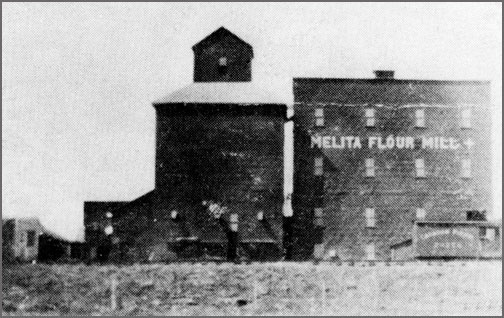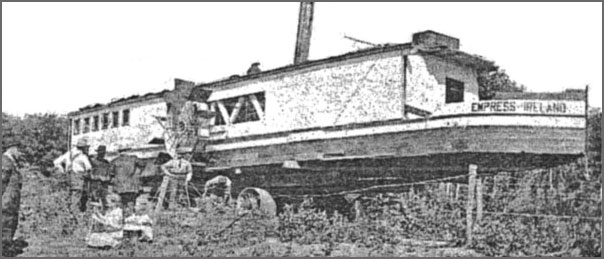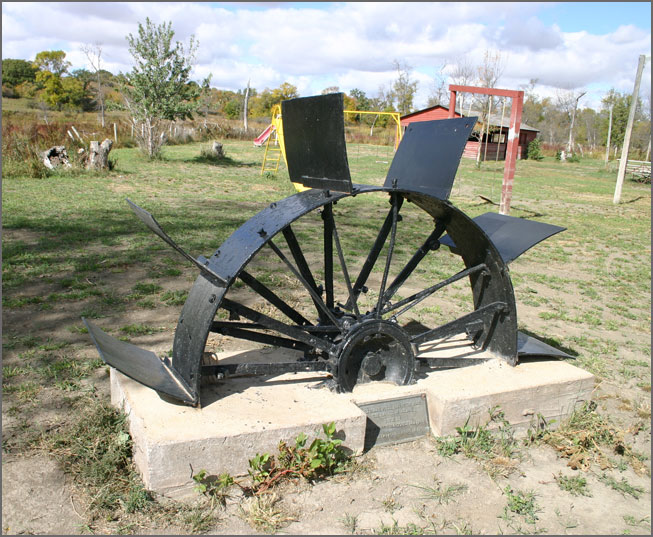|
Railway Towns
/ Melita
The settlement pattern in Manitoba’s extreme southwest corner followed the pattern established as settlement moved westward from Winnipeg. Settlers came, post offices were established, and they all waited for a railway to enter the district. Small villages and speculative towns appeared, but none of them decided to build a grist mill. Why? It is possible that they had looked at the experiences in Wakopa, and Deloraine and decided to just wait? In the meantime they would make the long trek to (Old) Deloraine. The establishment of the Melita Mill was voted on December 17, 1891, and first annual meeting of the Melita Milling Co. was held on January 26, 1892. The building was 36' x 48' in size and was four stories high. The engine house, also 36' x 48' was a solid structure to be lighted with electricity and fitted with all modern conveniences. The Melita Mill The establishment of the Melita Mill was voted on December 17, 1891, and first annual meeting of the Melita Milling Co. was held on January 26, 1892 The building was 36' x 48' in size and was four stories high. The engine house, also 36' x 48' was a solid structure to be lighted with electricity and fitted with all modern conveniences.  The building was 36' x 48' in size and was four stories high. The engine house, also 36' x 48' was a solid structure to be lighted with electricity and fitted with all modern conveniences. By 1900 the mill adopted a 24 hour system for a time at least. Mr. Powell engaged a night miller. T. Bulloch & Son built on an addition to the mill, as flour storage, (24 x 48 ft) to hold sixteen carloads of flour. In 1903 the entire plant was sold to Lamont and McDonald. The demand for Melita flour was great and the mill running day and night the year around. The enterprise saw the same ownership changes and problems that other mills faced, and various efforts to upgrade it and keep it operations. In 1913 the Melita Flour Mill, being thoroughly overhauled. The property was taken over by a local stock company, the capital being subscribed by townspeople and farmers in the district. This was typical of effort in other communities. Inevitably the mill was shut down but in this case the infrastructure continued to be used electric power generation Napinka Mill In 1892 the booming town of Napinka offered a $5000 bonus to start a mill. Someone took the offer, built the mill then skipped town. (Sun April 26, 1975)  While we have little information about the Roblin & Armitage mill in Napinka, we do have this photo from Bridging Brenda. The Melita Brick Co. In 1905 Mr. John Dobbyn (80 years of age) discovered a red brick clay just west of the river and south of today's #3 highway. He purchased the land (31-3-26) and ordered a modern brick making plant. The Melita Brick and Tile Co. was formed in April 1905. This consisted of John Dobbyn and son Richard, Charles D. Lamont and Johnston and Pope with manager of the brickyard being Richard. Dobbyn. In June the kiln was being built and great interest was taken in the result of the first kiln of brick, "fired". The bricks turned out a pretty shade of red. More than $10,000 had been invested in this project by July. In April of 1907, The Melita Brick Co. was making 20,000 bricks a day under manager D. Morrison. They had delivered a million bricks to Regina.  In 1909 these bricks were sold at Melita Lumber & Manufacturing Co. The yard closed in about 1910 as the clay bed had run out and the business had not proven to be a financially successful venture. However, many houses and buildings in the town and surrounding area stand today as proof of a very substantial "red brick" that was manufactured locally. Lime Kiln Along the Souris River, near Napinka, stonemason L.J. Phinney operated a kiln that likely supplied the mortar for the beautiful stone school that still stands in the village. Antler River Steel Works In pioneer farming communities, blacksmiths were indispensible. Untrained novice farmers could learn to build sod and log houses. They could learn to plant and reap. They proved up to the task of surviving in a harsh climate. But fixing broken machinery was a little more difficult for the do-it-yourself homesteader. When something broke on the farm, you needed it now. Blacksmiths often went far beyond repairs. It seems some of them were of an inventive, even creative turn of mind, and they just couldn’t resist making stuff. As we have seen many turned to making buggies. Others developed other interests. In 1908 “Captain” Hunt Johnston Rolston Large, a blacksmith from Coulter, Manitoba, got it into his head that he would build a steamship. From 1909 to 1910 the Empress of Ireland, his paddle-wheel steamship, plied the waters between Napinka, Manitoba (north of Melita) and Scotia, North Dakota on the Souris River.  The Empress of Ireland in Coulter, Manitoba – ready to launch in 1909. Large built his ship mostly out of recycled materials: a dismantled boxcar and the inside of an old house provided most of the wood he used in construction. The metal parts of the boat were made by Large himself in his little workshop, South Antler Steelworks. In the summer of 1910 the Empress left the Souris River to ply more lucrative waters: those of the Assiniboine near Brandon. She was transported by train and used as an excursion boat during the Brandon Fair. At the end of the summer she was tied down for the winter. An unfortunate accident caused her to burn down to the ice. All that was left was a portion of the hull, her two big boilers and the paddlewheels. Large reinvented her as a coal barge the next spring, but couldn’t bear to paint the word “Empress” on a barge, so renamed her the Assiniboine Queen. Severe floods in the spring of 1913 finally sank the craft.  One of the vessel’s steel paddlewheels, made by Large’s own hands, rests in Coulter Park at Sourisford. |
 |

|
 |